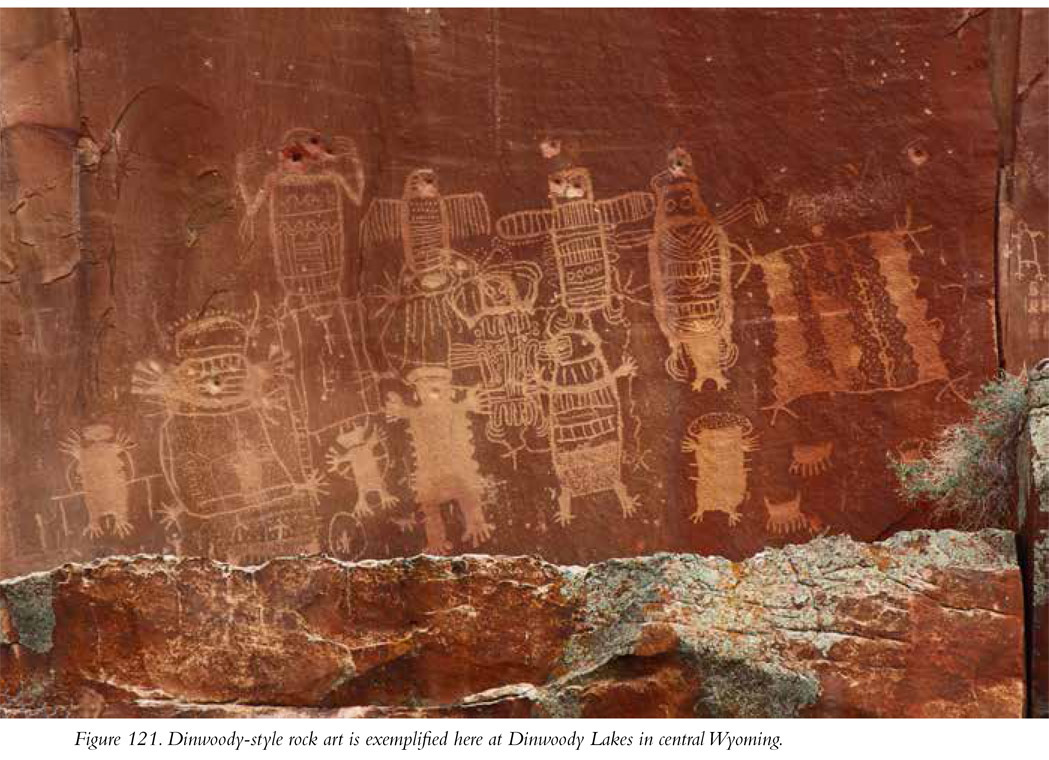
Crowheart, Wyoming
Journal Entry
August 23, 2014
Most art museums organize their exhibits both chronologically and stylistically. For example, in any given museum you may find a hall that features medieval paintings, another focused on the work of surrealists, and yet another exhibiting the paintings of abstract artists. If you’re like me, while you may not be an art historian or all that familiar with the various categories or subcategories of art, you clearly recognize the differences in the styles of, say, Renaissance painters like Raphael or Michelangelo; the crazy-cool, bizarre imagery of surrealists like Salvador Dali or René Magritte; and the rigid geometry of abstract artists like Mondrian.
We accept and even expect and celebrate the enormous diversity of Western art. Why should American Indian art be any different? It isn’t. The rock art already featured in this book exhibits some of that diversity: the Barrier Canyon pictographs in Site 40, Horseshoe Canyon and Site 45, Sego Canyon; the Fremont-style petroglyphs in Site 44, Nine Mile Canyon; the Jornada Mogollon imagery seen at Site 38, Three Rivers. Here we will visit the unique art of the Dinwoody style seen at a number of sites in Wyoming, as typified by the place that lends its name to that style: Din-woody Lake, near the town of Crowheart. The art I saw at Dinwoody (and another cluster located in Thermopolis, Wyoming, at Legend State Park) was unlike anything else I visited in my fifty-site odyssey. It is unique and beautiful.
What You Will See
Dinwoody Lake isn’t the biggest site in my fifty-site odyssey, and the number of individual elements in the art panel isn’t the largest. But the art is really quite stunning. When you reach what is essentially the terminus of West Dinwoody Lake Road and park in the cul-de-sac, just look up along the red-rock cliff to the west (Figure 121). There you will see an array of evocative images, some of which appear to be birds with outspread wings. The shape of the birds and, perhaps especially, the wide eyes suggest that the birds are owls. There are a number of images of upright, humanlike creatures with outstretched arms. Some of the creatures look like insects. All the images have richly detailed etching in their bodies, lots of horizontal and vertical lines. One of my favorites at Din-woody Lake is a rectangular image with geometric patterns and apparent fringe at all four corners. It looks like a blanket or rug.
Why Dinwoody Lake Is Important
I think one of the things that makes the Dinwoody art important, and one of the reasons I have included it in my fifty-site odyssey, is that it reflects the glorious diversity of Native American artists while, at the same time, showing the vast geographic spread of North American rock art. Using rock as a canvas onto which artists depicted plants and animals, spirits and gods, and realistic images of their surroundings, as well as phantasmagorical, almost hallucinatory images whose meaning we can only guess at, situates those artists firmly in the history of human creativity. Ancient America was populated by their own, and now unfortunately anonymous, Rembrandts and Picassos, Dalis, Kadinskys, and Rockwells. Though we will never know their names, we can revel in their art and in so doing afford them a kind of immortality.

Additional Note
The access road to the art—West Dinwoody Lake Road—is dirt, but like many encountered on our odyssey it’s passable as long as it hasn’t rained recently. After you turn onto it from US 26, you will reach the northern margin of the lake in a little less than 3 miles. At 4.3 miles from US 26, the road curves around to the right (west) when you have reached the end of the lake’s main body. Keep on that same road and you’ll see another body of water, Upper Dinwoody Lake. At a little more than 6 miles from US 26, close to the northwestern margin of Upper Dinwoody Lake, the road pretty much peters out and part of it curves back around into a cul-de-sac and parking area. Park here and look up at the cliff. Enjoy the art!
Site Type: Petroglyphs
Wow Factor: *** The art is beautiful.
Museum: None
Ease of Road Access: *** West Dinwoody Lake Road isn’t particularly well maintained, but it is flat. A high-clearance vehicle is a good idea.
Ease of Hike: ***** There’s really no hiking involved.
Natural Beauty of Surroundings: **** The lake is beautiful. We saw pronghorn antelope grazing nearby.
Kid Friendly: ***
Food: Bring your own.
How to Get There: The Dinwoody Lake petroglyphs are located on Wind River Indian Reservation lands, about 2 hours from Yellowstone National Park or 3.5 hours from Cody, Wyoming. Begin on US 26, an east–west highway that runs from Dubois to Crowheart in the middle of the state. From US 26 turn south onto West Dinwoody Lake Road. That dirt road will take you to the rock art.
Hours of Operation: There are no specific hours for Dinwoody Lake, but use common sense and go there during daylight hours. Arrive after sunrise; leave before sunset.
Cost: Free
Best Season to Visit: Any time other than winter is good.
Designation: Wind River Indian Reservation